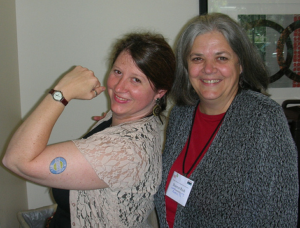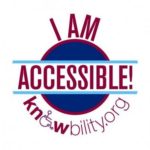 Back in 1998, an effort that became the nonprofit Knowbility started a hackathon competition before such events were called hackathons. It was called the Accessibility Internet Rally, or AIR, and in one day, professional web designers and web design students volunteered their time to build web sites for nonprofits in Austin, Texas – web sites that are fully accessible to people with disabilities and people using assistive technologies. Designers were divided into teams, and each team had a nonprofit to build for. The teams were all on one floor of a training center that donated its space and computers for the event.
Back in 1998, an effort that became the nonprofit Knowbility started a hackathon competition before such events were called hackathons. It was called the Accessibility Internet Rally, or AIR, and in one day, professional web designers and web design students volunteered their time to build web sites for nonprofits in Austin, Texas – web sites that are fully accessible to people with disabilities and people using assistive technologies. Designers were divided into teams, and each team had a nonprofit to build for. The teams were all on one floor of a training center that donated its space and computers for the event.
It was crazy, fun, exciting and, at times, silly. I was at that first competition, and at the events in 1999 and 2000, representing a partner organization, via the Virtual Volunteering Project. I helped greet and register every participant as they came in. I also ran through the hallways, into the training rooms, shouting deadlines, like “Two more hours! Just two more hours!” We got donated food from a local Subway shop and various grocery stores, and teams wouldn’t take a lunch break, despite our pleas for them to do so – they’d run into the room, scarf, then run back to their computers, ready for more designing. Austin-area corporations donated their branded swag that they had leftover from conferences in the past, or that had old logos on them, and we were able to put together goodie bags of memo pads, pens, frisbees and more to hand out to all participants. The second year, several corporate teams returned – this time with custom t-shirts they had made for their team especially for the competition! The event was so energizing and fun that teams came back year after year.
I still use the crockpot that we used to provide nacho cheese for teams…
The AIR competition has continued, and is still awesome, but a few years ago, it became an entirely online competition. It’s now called OpenAIR. The event is not limited to Austin, Texas – it’s global! Instead of one day, teams now have five weeks to develop new accessible web sites for participating nonprofits – and the web sites are far more sophisticated than they were back in the 1990s. A team’s members are all onsite together, at the same company or in the same web design class, for the most part, but they aren’t in the same room with the other teams, nor the nonprofits they are supporting – all interaction among teams and clients is via phone, online conferencing, email and shared online spaces. Another big difference from those early years is that, now, most of the participating nonprofits already have web sites, so their material is already digitized – we don’t need to scan logos or photos anymore, because it’s already done.
It’s almost 20 years after that first AIR competition, and I’m back with Knowbility, this time as a consultant, in charge of recruiting nonprofits to participate and supporting them through the entire process. And I have a goal: to find ways to recreate that craziness and fun and excitement and personal touch from the offsite, in-person events of the past online.
I’m supposed to be the virtual volunteering expert. So this should be a piece of cake for me, right? Afterall, I have ideas for creating a personal experience for working with online volunteers in The LAST Virtual Volunteering Guidebook. I’m using those recommendations, as well as looking through research I’ve curated about organizations working with online volunteers, information about virtual teams, remote teams, ework, telecommuting, etc., to come up with ideas… but I need more!
Here are my ideas so far:
- Talk one-on-one with the nonprofits as much as possible live via phone or web conference. There could be as many as 45 nonprofits participating, and while there are plenty of tools to communicate en masse with the nonprofits, and I will use many such tools, I’m also committed to talking, in real time, with EACH nonprofit, one-on-one, both right after they sign up and as they need it through the process. If I’ve been clear in those mass communications – on the web site, on the intranet, in email, etc. – then we’re talking about a few minutes at time in real-time communications, not hours and hours. But those one-on-one meetings are, IMO, essential to restore that personal touch and personality to participation.
- I’ll be asking each nonprofit to take a group photo of their staff holding a small 8 1/2 X 11” sign I will send them electronically, and that they will print out, that says something like “We’re in for #OpenAIR2018,” and then share via their various social media channels tagged with #OpenAir2018. And then Knowbility will share those photos as well via their social media channels, like Twitter and Facebook. That allows us to again see happy faces as a part of this event, and energize participants.
- I’m going to do some short, private videos for nonprofit participants – maybe 5 minutes – very informal, just giving them updates about what’s going on or something they need to keep in mind, and with each one, having a joke of the week, or some theme (Star Wars, Halloween, nature, pets, basketball, whatever) – hoping that both the key message and the silliness will guarantee viewers and energize participants.
- I’m going to have at least one live webinar, an “ask me anything” session, allowing nonprofits that have signed up to ask anything, “live”, and everyone in the webinars hearing my answers in real time. This is something PeaceCorps does periodically, and I really love how approachable it feels for participants.
- I’m hoping the design teams and nonprofits, after they are matched together, will do some screen captures of their meetings together and share them with me, so we can share them with other teams to show each other what they look like when they are working together. Silly hats could be encouraged.
- I’m going to ask the nonprofits to send something via postal mail to their design team. It can be a postcard of encouragement, a t-shirt from a previous event, a pen with their logo on it – just SOMETHING the web design team members can hold in a hand, something that represents the nonprofit in a personal way, something tangible, and something that didn’t have to be purchased or, if it did, was less than $2 and has something personal written on it by the nonprofit’s executive director or key contact (postcard!). If the NGO is, say, in Afghanistan, and has no way to send postal mail to the design team, I might ask them to send, via email, a recipe for a traditional Afghan dish, and ask the design team to share a photo of them enjoying the dish together.
- I’m going to ask the design teams to send something via postal mail to their nonprofits. Same rules: it can be a postcard of encouragement, a t-shirt from a previous event, a pen with their logo on it – just SOMETHING the nonprofit staff can hold in their hands, something that represents the design team in a personal way, something tangible.
Those are my ideas for getting more fun and a human touch back into this competition. The challenge is to come up with things that are free, simple, worthwhile to spend the time on, that teams won’t see as a burden, and that nonprofits won’t see as a waste of time. If something can’t be all of those things, it’s not going to work!
So, there’s my challenge. What are YOUR ideas? Remember those restrictions:
- free
- simple
- worthwhile
- not burdensome
- not a waste of time
Please put your fabulous ideas in the comments section!
 And if you represent a nonprofit, non-governmental organization (NGO), charity, public school, or any other not-for-profit, mission-based organization anywhere in the world, I hope you will consider participating in OpenAIR. Your organization gets a new web site that is accessible for people with disabilities, people who want to donate to your organization, volunteer for it, support it or otherwise participate it in some way. Imagine how being a more welcoming organization online will look to your current supporters and to potential donors! The sooner you sign up, the sooner you can start preparing for the competition, and the more support you will get. Although the deadline for signing up isn’t until the end of this year, if you wait that long, you miss out on more than three months of support and preparation for the event!
And if you represent a nonprofit, non-governmental organization (NGO), charity, public school, or any other not-for-profit, mission-based organization anywhere in the world, I hope you will consider participating in OpenAIR. Your organization gets a new web site that is accessible for people with disabilities, people who want to donate to your organization, volunteer for it, support it or otherwise participate it in some way. Imagine how being a more welcoming organization online will look to your current supporters and to potential donors! The sooner you sign up, the sooner you can start preparing for the competition, and the more support you will get. Although the deadline for signing up isn’t until the end of this year, if you wait that long, you miss out on more than three months of support and preparation for the event!
Also see:
- Why Have an Accessible Web Site?
- Benefits for your nonprofit participating in OpenAIR
- When and how does an OpenAIR nonprofit web site go live?
- Who designs the nonprofit’s new web site?
- What does a nonprofit have to do to participate in OpenAIR?
- How much time will this take?
- Nonprofit registeration for OpenAir
- Information for web designers that want to participate in OpenAIR
- Information for university students that want to participate in OpenAIR
Related blogs:







